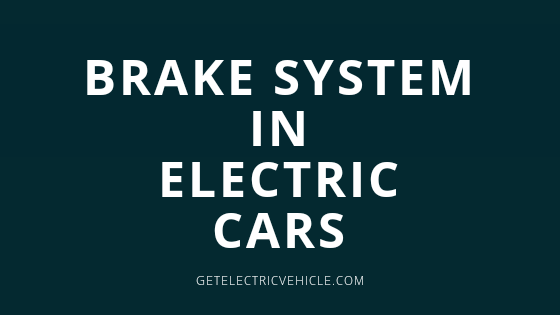
The Brake system is one of the most important components of a vehicle. Different types of brakes are used in automobiles. Some examples are drum brake, disc brake, etc. The developments of electric vehicles bring another type of braking system into the picture. How electric car brake system differs from a conventional vehicle brake system?
Before answering the question, let’s see what an electric vehicle is.
An electric vehicle is an automobile that uses one or more electric motors for propulsion. They are broadly classified into battery electric vehicles, hybrid electric vehicles, and plug-in hybrid electric vehicles.
We have a few detailed posts about electric vehicles here
- Basics of electric vehicle: Advantages, Disadvantages, and Classifications
- What is a Hybrid car?
- Basics of electric vehicle PDF download
A battery electric vehicle uses a battery to power the electric motor to propel the vehicle.
What is a brake system in vehicle?
A moving vehicle possesses kinetic energy and to stop the vehicle, the energy of the moving vehicle has to be converted into another form. The friction brake system in a conventional vehicle dissipates the kinetic energy of the moving vehicle in the form of heat energy.
If the total kinetic energy is transformed into another form of energy, then the vehicle stops. As a result of the friction, heat energy is being generated in the braking system when the vehicle brakes.
Disc brakes and drum brakes are the widely used brake systems in a internal combustion engine vehicle.
To know more about how the conventional brake system works, You may read “how the braking system works?“
How does electric car brake system work?
Now let’s think about the question “how does electric car brake system work?”
Mechanical braking is provided in an electric vehicle to delegate and stop the vehicle whenever necessary. Similar to the IC engine vehicle, the brake system in the electric vehicles shall be disc or drum brake.
When we accelerate the vehicle, energy in the battery flows to the electric machine to drive it. The energy required to move the vehicle is taken from the battery of the electric vehicle.
The actuator pedal is released to slow down the vehicle and when it is completely released, the power flow to the motor from the battery stops. As a result, the vehicle starts to decelerate due to the aerodynamic drag, rolling friction,and other forces that oppose the movement of the vehicle.
But those friction forces are not sufficient to stop the vehicle and hydraulic brakes are also applied. So, the kinetic energy is converted to heat energy at the brake, and the vehicle stops.
Along with the friction brake system, another type of braking is also possible in an electric vehicle. It is known as regenerative braking.
In regenerative braking, the energy that would have been lost as heat during braking is tapped and stored back in the battery. The electric machine that propels the vehicle acts as a generator during the deceleration and braking to convert the kinetic energy to electric energy.
Power electronics converters with bidirectional power flow help out here to store the electric energy generated during braking in an electric vehicle.
The idea of regenerative braking system in an electric car
The idea of regenerative braking enables the vehicle to generate electric energy from kinetic energy. When the vehicle decelerates, the electric motor acts as a generator and generates electricity from the kinetic energy of the vehicle.
Instead of applying friction brake to the vehicle, “electric brake” is being applied.
As the vehicle stops, friction brakes are also applied to keep the vehicle standstill. There are many factors that affect the effectiveness of regenerative braking. The mass of the vehicle, speed, battery state of charge, etc. are a few of them.
- Energy recuperation can be used when the vehicle moves down in a slop
- A 10 to 25% additional range benefit is obtained from the regenerative brake system in a car
Another factor that affects the efficiency of regenerative braking is the drive cycle. For example, on a highway where the speed is almost constant, the chances of energy recuperation are much less.
You may read this post to know more details about regenerative braking: What is regenerative braking in an electric car? Theory, advantages, and disadvantages
The regenerative braking technology is getting advanced day by day and it helps out the vehicle to be driven only using one pedal. Here is an article about one pedal driving of electric vehicle.
[READ]: One pedal driving in electric cars: Why do you need a redundant brake pedal?
Conclusion
Most electric cars use both mechanical and regenerative braking systems together. An electric car brake system recuperates the energy that would have been lost during braking and stores it in the battery. This provides an additional 10 to 25% range to the vehicle.
In addition to the energy-saving, the regenerative braking technology helps out to improve the life of the friction brake system as well.
Don’t forget to share this post with your friends and follow us on Facebook, LinkedIn, and YouTube!
Key points
- The electric car brake system uses both friction and regenerative braking technologies
- 100% regenerative braking is not yet implemented in an electric car
- One pedal driving vehicles use more effective regenerative braking
- Friction braking is also necessary for an electric car